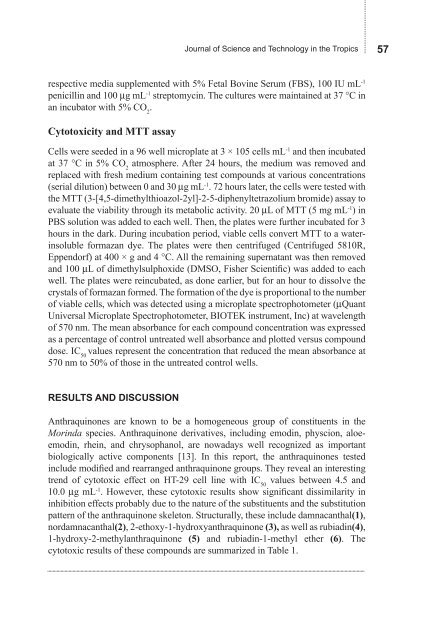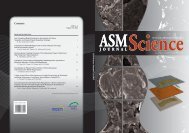Download - Akademi Sains Malaysia
Download - Akademi Sains Malaysia
Download - Akademi Sains Malaysia
You also want an ePaper? Increase the reach of your titles
YUMPU automatically turns print PDFs into web optimized ePapers that Google loves.
Journal of Science and Technology in the Tropics 57<br />
respective media supplemented with 5% Fetal Bovine Serum (FBS), 100 IU mL -1<br />
penicillin and 100 mg mL -1 streptomycin. The cultures were maintained at 37 °C in<br />
an incubator with 5% CO 2<br />
.<br />
Cytotoxicity and MTT assay<br />
Cells were seeded in a 96 well microplate at 3 × 105 cells mL -1 and then incubated<br />
at 37 °C in 5% CO 2<br />
atmosphere. After 24 hours, the medium was removed and<br />
replaced with fresh medium containing test compounds at various concentrations<br />
(serial dilution) between 0 and 30 mg mL -1 . 72 hours later, the cells were tested with<br />
the MTT (3-[4,5-dimethylthioazol-2yl]-2-5-diphenyltetrazolium bromide) assay to<br />
evaluate the viability through its metabolic activity. 20 mL of MTT (5 mg mL -1 ) in<br />
PBS solution was added to each well. Then, the plates were further incubated for 3<br />
hours in the dark. During incubation period, viable cells convert MTT to a waterinsoluble<br />
formazan dye. The plates were then centrifuged (Centrifuged 5810R,<br />
Eppendorf) at 400 × g and 4 °C. All the remaining supernatant was then removed<br />
and 100 mL of dimethylsulphoxide (DMSO, Fisher Scientific) was added to each<br />
well. The plates were reincubated, as done earlier, but for an hour to dissolve the<br />
crystals of formazan formed. The formation of the dye is proportional to the number<br />
of viable cells, which was detected using a microplate spectrophotometer (mQuant<br />
Universal Microplate Spectrophotometer, BIOTEK instrument, Inc) at wavelength<br />
of 570 nm. The mean absorbance for each compound concentration was expressed<br />
as a percentage of control untreated well absorbance and plotted versus compound<br />
dose. IC 50<br />
values represent the concentration that reduced the mean absorbance at<br />
570 nm to 50% of those in the untreated control wells.<br />
RESULTS AND DISCUSSION<br />
Anthraquinones are known to be a homogeneous group of constituents in the<br />
Morinda species. Anthraquinone derivatives, including emodin, physcion, aloeemodin,<br />
rhein, and chrysophanol, are nowadays well recognized as important<br />
biologically active components [13]. In this report, the anthraquinones tested<br />
include modified and rearranged anthraquinone groups. They reveal an interesting<br />
trend of cytotoxic effect on HT-29 cell line with IC 50<br />
values between 4.5 and<br />
10.0 mg mL -1 . However, these cytotoxic results show significant dissimilarity in<br />
inhibition effects probably due to the nature of the substituents and the substitution<br />
pattern of the anthraquinone skeleton. Structurally, these include damnacanthal(1),<br />
nordamnacanthal(2), 2-ethoxy-1-hydroxyanthraquinone (3), as well as rubiadin(4),<br />
1-hydroxy-2-methylanthraquinone (5) and rubiadin-1-methyl ether (6). The<br />
cytotoxic results of these compounds are summarized in Table 1.

















